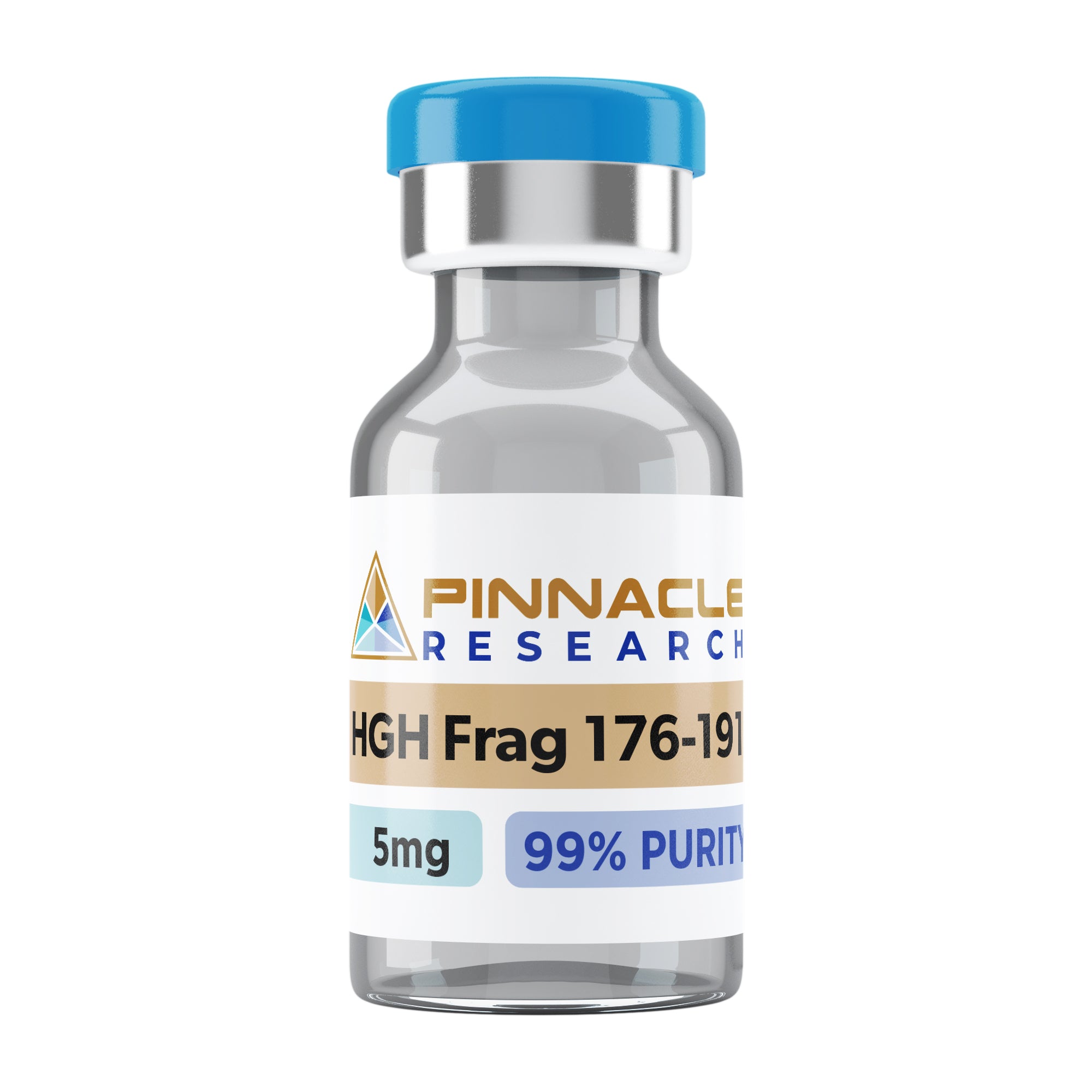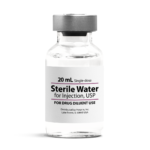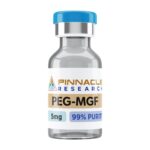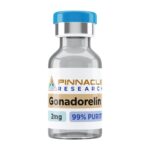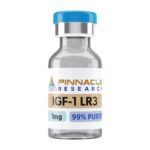About HGH Frag 176-191
The HGH Frag 176-191 is an artificial peptide and a small piece of the body’s natural human growth hormone (hGH). It is commonly known as a “lipolytic fragment”, which is considerably associated with its fat-loss triggering abilities. Previous studies on peptide compounds also show that they can promote cartilage healing and lower blood sugar levels while promoting long bone growth and increasing IGF-1 levels. Let’s dive deeper and understand more about the HGH Frag 176-191 artificial peptide.
What Is HGH Fragment 176-191?
The HGH Fragment 176-191 is the artificially modified version of AOD9604. It is a tiny fragment of the hGH and is commonly known as a “lipolytic fragment”. The research compound has earned the name because research studies on the compound revealed it triggers fat loss in mice, which have been genetically modified to produce large body fat stores. Researchers have been investigating the HGH Fragment 176-191 peptide effects on various animal models and observing how it preserves the fat-burning capabilities exhibited by hGH. Even though the peptide has the fat-burning capabilities of the human growth hormone, it doesn’t have some side effects of its parent compound. Prevalent side effects associated with hGH are:
- Altering insulin sensitivity
- Negatively affecting carbohydrate metabolism
- Increasing levels of insulin-like growth factor-1 levels
- Promoting long bone growth
The targeted effects of the peptide make it helpful in researching and exploring the human body fat metabolism, which in turn will provide a basis for building medication that can deal with obesity.
The HGH Fragment 176-191 Peptide Chemical Structure
- Sequence: Tyr-Leu-Arg-Ile-Val-Gln-Cys-Arg-Ser-Val-Glu-Gly-Ser-Cys-Gly-Phe
- Molecular Formula: C78H125N23O23S2
- Molecular Weight: 1817.12 g/mol
HGH Fragment 176-191 Research and Effects
Lowering Blood Sugar Levels
Past research studies on animals discovered that the end of the hGH’s c-terminal was responsible for triggering the protein’s hypoglycemic (lowering blood sugar) effects. Protein hypoglycemia is the process of lowering blood sugar in the body. During the research studies, more than six different fragments were tested. The fragments were derived from a specific section of the hGH, and it showed that the HGH Fragment 176-191 compound was the most effective synthetic fragment of hGH in decreasing blood sugar levels. Findings from the study also revealed that the effect was secondary, and the compound also triggered a sustained increase in the body’s plasma insulin levels. These findings have sparked interest in the possibility of using the HGH Fragment 176-191 peptide in treating type 2 diabetes and prediabetes conditions.
Triggering Weight Loss and Fat Burning
The HGH Fragment 176-191 compound is famed for being the “lipolytic fragment” due to its impressive capabilities in triggering weight loss and substantial fat burning. Scientists discovered the capabilities of the compound in enhancing weight loss and substantial fat-burning processes during research studies on rats. Scientists believe the peptide achieved the noted results by increasing the production of β3-AR or ADRB3 (beta-3 adrenergic receptors).
The agonist action on the ADRB3 directly increases fat burning process in the adipose tissue and thermogenesis in skeletal muscle. Genetically modified mice that don’t produce the beta-3 adrenergic receptors didn’t respond to the lipolytic effects of the peptide or hGH. Further studies revealed that the increased fat burning triggered by HGH fragment 176-191correlated with energy expenditure, which in turn caused increased weight loss. During the study, obese animals experienced close to 50% weight reduction in three weeks.
The impressive weight loss was only observed in obese animals, while the animals with lean muscle mass maintained their body weight even when administered the HGH fragment 176-191 peptide. Findings from the study suggest that the compound might have other additional chemical reactions which trigger fat burning and weight loss in obese animals. The secondary lipolysis regulatory pathways are suspected of overriding ADRB3 functionality when one has an ideal weight, which has sparked more scientific interest in energy homeostasis.
Promoting Cartilage Regeneration
While most scientific studies on the HGH fragment 176-191 peptide have primarily focused on its lipolytic properties, scientists have started other research studies focusing on other unknown health benefits derived from the compound. According to a 2015 Korean research article, the peptide might potentiate the hyaluronic acid injections’ effects and enhance cartilage regeneration. The research studies involved rabbits, and the weekly HGH fragment 176-191 peptide dosage increased the laboratory measures of the body’s cartilage growth. The peptide compound was used together with hyaluronic acid (HA) during the study, triggering more substantial effects. It was also discovered that the HGH fragment 176-191 peptide, independently or combined with hyaluronic acid, reduced disability caused by osteoarthritis.
Scientists believe the peptide could be instrumental in creating treatments for advanced osteoarthritis cases and eliminating the need for surgical treatments.
The HGH Fragment 176-191 Research Safety Studies
Scientists have been concerned that the fantastic weight loss capabilities of the HGH Fragment 176-191 peptide might cause unwanted side effects. The concerns have been raised because long-term exogenous use of hGH has been associated with the following side effects:
- Increased insulin resistance,
- Cancer
- Diabetes,
- Hypertension (high blood pressure)
- Acromegaly,
- Edema (swelling).
A 2013 research study evaluated six case studies of fragment HGH 176-191, focused on investigating the significance and rate of side effects caused by the compound. Findings from the study suggest that the peptide retains most of the benefits of the hGH but doesn’t have the severe side effects associated with the human growth hormone. They also recommend the further study fragment HGH 176-191 in a clinical setting but with regulatory approval for test and use.
Even though the human growth hormone has anabolic effects, the HGH Fragment 176-191 compound is explicitly preferred because of its exceptional ability to lose side effects. Additional studies on mice revealed that HGH Fragment 176-191 doesn’t cause an increase in cell proliferation.
The HGH Fragment 176-191 peptide is famous for its fat-burning capabilities hence the name “lipolytic fragment”. While the peptide has been considerably associated with many weight loss and fat-burning capabilities, researchers are looking deeper into the possibility of the compound triggering any side effects. The previous rescue on the peptide predominantly focused on lipolysis and weight loss, but researchers are now expanding the horizon on the HGH Fragment 176-191 peptide research studies. Connective tissue regeneration is the primary area of interest in HGH Fragment 176-191 peptide research studies.
The HGH Fragment 176-191 peptide can help individuals achieve impressive weight loss and fat-burning goals. The compound is still undergoing more research and is available for research and educational purposes.
